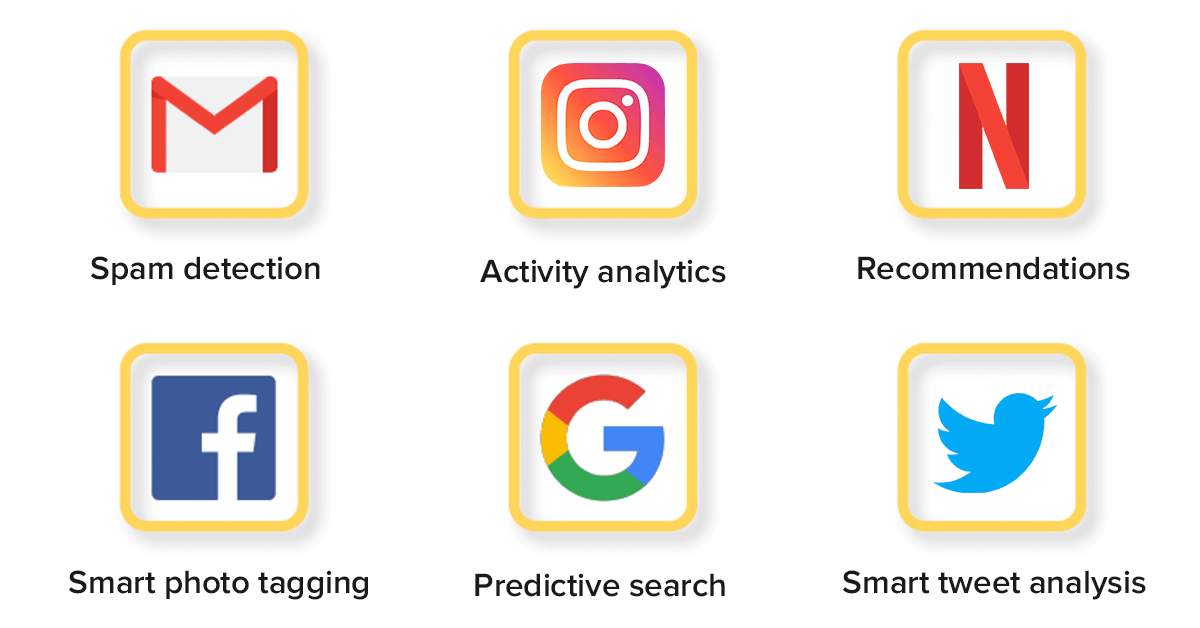Artificial intelligence can be aptly dubbed the technology of the 21st century. It has become so viral that even app publishers are wondering how to build AI mobile apps to draw in more users.
Realizing the dominance of artificial intelligence in business, top-rank companies like Amazon, eBay, and Tinder integrate AI extensively in their applications to provide personalized mobile user experiences and boost profitability. The tendency is so pronounced that tech scions predict around 95% of customer interactions to be powered with AI by 2025.
If you’re looking to join this niche and build an AI app, this blog post will explain in detail how to make an AI app and why you need AI integration.
What is AI in apps and how does it work?
Artificial intelligence is ingrained in our mobile devices whether we realize it or not. It’s responsible for things like predictive text, autocomplete, and even face ID.
According to recent reports, Apple remains among the huge AI believers with billions of dollars injected into artificial intelligence. Samsung is not far behind, investing $206 billion in AI and other next-gen technologies. Besides hardware, these companies embed intelligence to support their users’ journeys and make any application more intuitive.

Source: Unsplash
All applications of AI in mobile apps can be divided into four big groups. These correlate with the abilities of the human brain.
Reasoning
This superpower is the lifeblood of all AI-powered mobile apps development ideas. Reasoning allows machine intelligence to identify the relationships between objects and respond in a way that is consistent with human intelligence. This ability is at the core of most smart applications, including the Socratic app, Replika, and others. The reasoning is what lays the ground for other human-like powers.
Planning
The predictive potential of AI in mobile apps is one of the fundamental applications. Prediction is the ability to estimate or infer something about the future based on present evidence. In order for machines to effectively make predictions, they must be able to learn from data and identify patterns.
You can see predictions in search autocomplete on the Youtube app or Lisa, which is an Instagram engagement predictor. Google Maps uses machine learning models to predict the traffic, an estimated travel time, and an estimated time of arrival.
Classification
In artificial intelligence, classification is the task of identifying which category an entity belongs to. Classification is important for many AI applications such as vision, speech recognition, and natural language processing. Siri is a textbook example of a mobile app that relies on natural language processing.
Creativity
Although the flow of machine creativity cannot be put in line with ours, AI apps can still generate new outputs. In most cases, machine intelligence supports human imagination and produces ideas that can fuel our creative process. Apps like Crystalknows, for example, help users adjust their email style to make a better pitch. Magisto, which is an AI video editor, is another example of how applications help users be more inventive.

Source: Unsplash
These four groups of tasks create the stage for more specific intelligent applications such as text analysis or face recognition. With that said, let’s go over popular AI-powered mobile app development ideas that leverage those smart abilities.
How is AI used in mobile apps?
According to Business of Apps, there are around 4.40 million apps on the App Store and Google Play. A rich landscape makes mobile development a competitive ecosystem. To pique users’ interest, companies spice up their applications with smart functions. App AI solutions vary greatly, so let’s have a look at some of the most exciting AI-powered mobile app development ideas.
Object detection and facial recognition
In mobile apps, facial recognition has found multiple applications. Firstly, the technology can be used to identify a person in a photograph or video. It analyzes the shapes and features of a person’s face and compares them to the faces of other people in a database. This allows mobile apps to automatically tag or share photographs of the people in them, without having to enter their names manually.
Facial recognition can also be used to unlock devices, log in to apps, and purchase items. Healthcare applications include face detection as a part of their tech stack. With AI, your health status is one scan away with an application mapping your face landmark.
Face2Gene is a prominent example in the category. The solution scans a patient’s photo and uses machine learning to match the output to rare genetic conditions.
Predictive search
Predictive search is a feature that makes it easier and faster for users to find what they’re looking for. With predictive search, the app tries to guess what the user is searching for as they type. This makes it possible to find information without having to finish typing the entire query. Find-as-you-type is quite a simple smart feature that is considered a given in streaming applications, dictionaries, review apps, and others.
Gmail, for example, offers suggestions by default along with other popular products.

Source: Unsplash
Predictive analytics
This type of technology is mostly a publisher-facing feature that collects actionable insights about users’ in-app behavior. By analyzing historical user data, companies can identify which behaviors are indicative of churn and use that information to develop models that can predict which users are most likely to churn. Armed with this data, app owners can take steps to prevent churn and retain valuable users.
Predictive analytics is also used in financial applications to prevent fraud. Fintech products use this technology to foresee the user’s estimated spending, thus facilitating easier finance management. US Bank, for example, monitors payment channels for suspicious transactions to detect fraud.
Recommendations
In-app recommendations enable retailers, insurance providers, wellness companies, and other B2C companies to deliver highly personalized product recommendations at scale. To do that, the solution leverages custom machine learning models. The latter analyzes user browsing and purchase history and then predicts users’ choices. Amazon’s collaborative filtering, which is a recommendation engine, helped rake in an additional 35% of sales.
Emotion recognition
Emotion artificial intelligence attempts to read human emotions. The solution can detect the emotions of a person through their facial expressions and audio input. The system can also discern user emotions via text, using natural language processing. By 2027, this technology will be present in the majority of solutions with an estimated market of $43.3 billion.
Emotimeter is a popular example of a merely smart-based app. It can detect emotions from facial expressions from the images obtained by the camera.
Natural language processing
Natural Language Processing or NLP is an intelligent field that allows computers to analyze human languages. NLP allows us to apply machine learning algorithms to text and speech. The NLP market demonstrates skyrocketing growth. In 2020, the market stood at $11.1 billion. By 2030, it is estimated to reach $341.5 billion.

Common examples include Google Assistant, Alexa, and Siri. Google also applies language analysis for spam detection. Even hiring solutions rely on NLP to source relevant candidates.
How much does it cost to build an AI app?
There are many considerations when looking at the cost to create an AI app. It all depends on the level of complexity, which includes the number of integrations, algorithms, and data analysis.

Along with app complexity, the main cost drivers include:
- Prebuilt or custom features;
- Number of platforms (iOS, Android);
- The type of technology you’re aiming for;
- The accuracy of your smart algorithm;
- The amount and quality of data.
The project pricing is also premised on basic cost drivers. These include project scope, timeframe, and your team’s location. Therefore, accurate estimation is only possible at the discovery stage when your team has a holistic vision of the future product.
How to make an artificial intelligence app: step-by-step
Now that you have more exposure to the specifics of smart development, let’s see how to make AI applications. Typically, any AI software development company follows a similar roadmap, be it an NLP solution or a recommendation engine.
Identify a problem
The whole development process is based on a unique business problem that you’re trying to solve. Alternatively, this can be a customer challenge for a customer-facing solution. To do so, you should perform extensive business and market research. The latter may include internal operations for B2B solutions or customer journeys and personas for B2C products.
Product discovery is crucial to saving time and financial resources as well as setting up your solution for success.

Source: Unsplash
Decide on the vendor
Next, you should select a few potential AI partners that can bring your business idea to life. However, with a choice so wide, it’s hard to shortlist your future partners.
Here are some criteria to help you make the right choice:
- Company’s experience – seasoned market presence inherently hints at more skills and technologies at hand.
- Proven track record – an impressive portfolio of similar projects will allow you to set clear expectations.
- AI technologies – suitable expertise will double your chances of successful collaboration.
- Positive brand image and customer reviews – reputable intelligence teams are easily discoverable online and have a high rating on Clutch and similar platforms.
Moreover, you should factor in the location of your future vendor since it impacts the pricing and regulatory nuances.
Design your solution
Once you sign an agreement with your technology partner, it’s time to create design mockups of your app. To do that, the design team will perform thorough market studies and map the user journeys. The result of this stage is a final layout that is then sent to the development team.
Choose a tech stack
Depending on the complexity of the AI app, a developer will need to use a combination of programming languages and frameworks. Usually, the exact set of technologies depends on the solution and quality of data. An intelligent application relies both on traditional technologies and smart solutions that promote automation.
However, there are some niche-specific suspects when it comes to artificial intelligence.
Programming languages and libraries
Python dominates the landscape when it comes to traditional smart-friendly languages. However, mobile platforms necessitate the usage of mobile-based languages. Thus, Kotlin is a popular option for Android development, while Swift and Objective-C cater to iOS.
As for machine learning libraries, TensorFlow and scikit learn are among the most useful tools for smart projects. Also, platforms like Microsoft Azure, IBM Watson, and Amazon Machine Learning simplify app-building and routine procedures, thus bringing down development time.

Source: Unsplash
Frameworks and APIs
Application programming interfaces and frameworks simplify the creation of smart algorithms. Thus, they offer ready solutions for deep learning, neural networks, and NLP applications. Keras, Theano, and Pytorch help developers build algorithms with speed, flexibility, and simplicity.
Create and train an AI algorithm
Smart algorithms are what will grant your application human-like capabilities. Algorithm creation, however, is a time-consuming process that depends on the data quality. Thus, unstructured or siloed data will hamper the process and require more time to get cleaned and unified.
Once your data is ready, the BI team will model and train the algorithm. The one that yields the greatest accuracy ends up as the final solution.
Launch an MVP
Now that all ingredients are ready, your team can test the viability of your solution. A Minimum Viable Product is an early version of your application. It includes only a must-have set of features that are enough to test the application with the final users. Once the team gathers user feedback, they can polish the solution and build a full-fledged application.
Maintain and update your product
To prevent data drift, the support team provides regular maintenance activities for your solution. AI maintenance is different from other applications since it requires constant data and concept updates. The latter will ensure your algorithm accuracy remains at the same level with no degradation. Regular updates such as security patches and version changes also come to that.
Top industries to benefit from AI apps
Smart capabilities are commonly associated with retail and manufacturing industries. But the potential of machine intelligence goes well beyond that. If you’re still wondering how to develop an AI solution and whether it’s worth it, let’s behold the power of automation in different industries.
Healthcare
Artificial intelligence in the healthcare market will grow to $67.4 billion by 2027. The rapid adoption is underpinned by increasing medical costs and labor shortages. Intelligent solutions, however, can amplify clinical decision-making and optimize operational efficiency. Moreover, technology can assist patients in health management, thus bringing more enablement to both sides.

Source: Unsplash
The Happify app illustrates the value of automation. It is a mental health solution that offers engaging events, and other activities led by a digital AI instructor. The BioBase app aggregates insights from wearables and then evaluates them in real-time using smart analytics.
At InData Labs, we’ve also worked on multiple smart healthcare projects. Thus, our team helped the Flo app improve predictions of irregular cycles for application users. During another project, we implemented NLP functionality for a fitness app to make it more personalized.
Transportation and logistics
According to the European parliament, automation can be brought to all transportation branches. From railway transport to aviation, smart solutions introduce greater efficiency and safety. Mobile products, in turn, can support intelligent logistics or control driverless vehicles. Other use cases of pocket AI solutions include fuel monitoring, truck location detection, and route planning.
AI solutions also aggregate real-time and historical data from multiple connected devices and systems (including SCM, ERP, and CRM systems). This miscellaneous information can then be analyzed to provide broader and deeper performance information for decision-makers, be it supply or shipping.
For instance, Uber implements smart computing for driver onboarding and route optimization. The app also matches drivers and riders based on their proximity. The company also leans on Michelangelo, which is an internal ML platform. UberEATS uses Michelangelo to predict meal delivery time.
Education
The critical presence of teachers cannot be replaced with technologies. Instead, machine learning can complement studying approaches and make education more interactive. In its recent publication, UNESCO estimated the worth of AI in education at $6 billion by 2024. The organization also suggests that smart technologies can address some of the biggest challenges in education today as well as innovate teaching and learning practices.

Source: Unsplash
While we are yet far from automated teaching, smart applications are already in wide use in the EdTech sector. AI-based grading apps save teachers’ time by reading students’ handwriting and automating grading. Self-learning tools like ELSA help students master new skills and polish their pronunciation. ELSA Speak has gained great recognition and has an estimated $22.6 million of annual revenue.
Finance
For finance, no tech breakthrough is complete without computer intelligence. The latter is what promotes fintech and makes financial transactions more secure and faster. Today, over 50% of financial services organizations with 5,000+ employees have adopted AI.
Benefits of AI mobile apps support a whole range of financial activities, including:
- Credit scoring;
- Transaction security;
- Fraud prevention;
- Customer service;
- Automated document processing, and others.
Fintech mobile apps are burgeoning as well with neobanks seeing a 30% YoY increase.
Mint, which is a popular budgeting app, makes great use of automation and AI. The application reels in users by providing budget classification, real-time dashboards, and automated bill management.
The Binance app also employs automation functionality. This well-known crypto solution comes with automated crypto trading made possible with smart bots.
Marketing
Last but not least, intelligent products support marketing initiatives and allow users to generate granular outreach efforts. AI can help teams deliver targeted messages to customers at an appropriate time and place. Machine intelligence can also help marketers prevent churn and re-engage reluctant users.
AI in digital marketing enhances the customer experience and provides a wide arsenal of ways to connect across platforms. Artificial Intelligence methods further eliminate the risks associated with human error and increase the efficiency of existing processes by minimizing manual labor.
The automated marketing market size is expected to stand at $107,535.57 million. The increasing adoption of user-focused strategies and dominance of social media urge companies to leverage smart tools.

Source: Unsplash
Grammarly is a popular unicorn app that caters both to businesses and individuals. Its Business extension assists marketers with better wording to boost readability, delivery, and engagement. Yotpo is another smart tool that analyzes customer feedback and sentiments, and then suggests product improvements to companies.
How to build an AI app: the outcome
Artificial intelligence is the technology to stay. Thanks to unrivaled automation and human-like capabilities, AI will gain traction in the upcoming years. Mobile development is rapidly adopting AI functionalities to deliver more value to end-users.
Today, the majority of mobile solutions have AI at their core. From fintech products to social media to telemedicine applications, automation is omnipresent. However, AI-driven mobile app development involves in-depth experience and thorough algorithm expertise.
Develop AI-powered mobile applications with us
If you’re still wondering how to make an AI application, contact our specialists and they will help you address this question.

